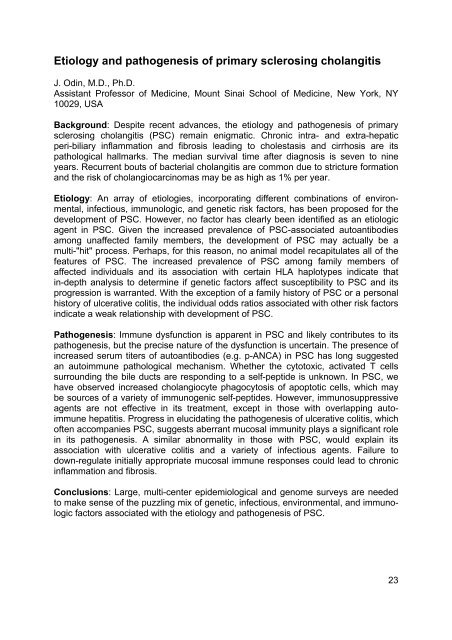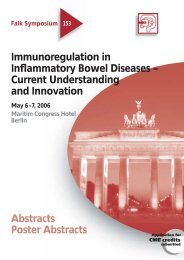Abstracts Poster Abstracts - Dr Falk
Abstracts Poster Abstracts - Dr Falk
Abstracts Poster Abstracts - Dr Falk
You also want an ePaper? Increase the reach of your titles
YUMPU automatically turns print PDFs into web optimized ePapers that Google loves.
Etiology and pathogenesis of primary sclerosing cholangitisJ. Odin, M.D., Ph.D.Assistant Professor of Medicine, Mount Sinai School of Medicine, New York, NY10029, USABackground: Despite recent advances, the etiology and pathogenesis of primarysclerosing cholangitis (PSC) remain enigmatic. Chronic intra- and extra-hepaticperi-biliary inflammation and fibrosis leading to cholestasis and cirrhosis are itspathological hallmarks. The median survival time after diagnosis is seven to nineyears. Recurrent bouts of bacterial cholangitis are common due to stricture formationand the risk of cholangiocarcinomas may be as high as 1% per year.Etiology: An array of etiologies, incorporating different combinations of environmental,infectious, immunologic, and genetic risk factors, has been proposed for thedevelopment of PSC. However, no factor has clearly been identified as an etiologicagent in PSC. Given the increased prevalence of PSC-associated autoantibodiesamong unaffected family members, the development of PSC may actually be amulti-"hit" process. Perhaps, for this reason, no animal model recapitulates all of thefeatures of PSC. The increased prevalence of PSC among family members ofaffected individuals and its association with certain HLA haplotypes indicate thatin-depth analysis to determine if genetic factors affect susceptibility to PSC and itsprogression is warranted. With the exception of a family history of PSC or a personalhistory of ulcerative colitis, the individual odds ratios associated with other risk factorsindicate a weak relationship with development of PSC.Pathogenesis: Immune dysfunction is apparent in PSC and likely contributes to itspathogenesis, but the precise nature of the dysfunction is uncertain. The presence ofincreased serum titers of autoantibodies (e.g. p-ANCA) in PSC has long suggestedan autoimmune pathological mechanism. Whether the cytotoxic, activated T cellssurrounding the bile ducts are responding to a self-peptide is unknown. In PSC, wehave observed increased cholangiocyte phagocytosis of apoptotic cells, which maybe sources of a variety of immunogenic self-peptides. However, immunosuppressiveagents are not effective in its treatment, except in those with overlapping autoimmunehepatitis. Progress in elucidating the pathogenesis of ulcerative colitis, whichoften accompanies PSC, suggests aberrant mucosal immunity plays a significant rolein its pathogenesis. A similar abnormality in those with PSC, would explain itsassociation with ulcerative colitis and a variety of infectious agents. Failure todown-regulate initially appropriate mucosal immune responses could lead to chronicinflammation and fibrosis.Conclusions: Large, multi-center epidemiological and genome surveys are neededto make sense of the puzzling mix of genetic, infectious, environmental, and immunologicfactors associated with the etiology and pathogenesis of PSC.23



